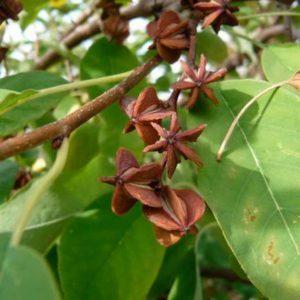Chinese star anise (Illicium verum)
[Jaimie Sweetman is part of the Edible Forest located on the Yarra Valley Estate in Dixons Creek. There are regular tours of the Edible Forest – read more and book your place on a future tour.]
 [Editor: Chinese star anise is a spice is used in Indian, Chinese and other Asian cuisines. It is also used in the French recipe of mulled wine and in the liqueur Galliano. It contains anethole, the same compound that gives the unrelated anise its flavour, and can be used as a less expensive substitute for anise in baking. Star anise oil is a highly fragrant oil used in some perfumery, soaps, toothpastes, mouthwashes and skin creams.]
[Editor: Chinese star anise is a spice is used in Indian, Chinese and other Asian cuisines. It is also used in the French recipe of mulled wine and in the liqueur Galliano. It contains anethole, the same compound that gives the unrelated anise its flavour, and can be used as a less expensive substitute for anise in baking. Star anise oil is a highly fragrant oil used in some perfumery, soaps, toothpastes, mouthwashes and skin creams.]
In our hunt for unusual plants, we found a Chinese star anise plant. It is a frost tender, sub-tropical plant, so we have ours in a position which is protected from winds and gets dappled afternoon sun. Although this area still gets cold, our hope is that all the plants (which include Davison’s plums, canna lilies, cold temperature paw paws, aniseed myrtles and hazelnuts) will eventually protect each other and help create more humidity over time.
Originating from China down to Vietnam, you have probably used or seen the star-like seed pods of the Chinese star anise. It has an anise perfume and taste but it is the star-like seed pods that are most often used. It can take up to 7 years for them to start producing pods.
The tree is evergreen and can get up to 6 metres high and 3 meters wide in optimal conditions. It can also be hedged back to form a scented hedge.
It is the dried star seed pods that are harvested.
